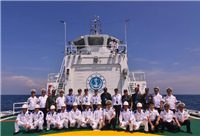

Multilateral lender seeks ways to leverage capabilities as more challengers emerge
The Asian Development Bank will work with the China Development Bank and Export-Import Bank of China to co-finance projects outside of China, ADB Vice-President Stephen Groff said.
This is part of the Manila-based multilateral lender's strategy to enhance its financial capacity to remain relevant in a region where emerging institutions such as the CDB and the new Asian Infrastructure Investment Bank dwarf its capacity.
Groff said that the ADB has signed a memorandum of understanding with the CDB and the China Eximbank to "look for opportunities outside of China". The ADB has not yet identified appropriate projects for this purpose, he said.
To cope with its limited lending capacity, the ADB has in recent years pursued a strategy called "Finance Plus Plus": The first "plus" is leverage, and the second is knowledge.
"It can be $1 from the ADB, $1 from the World Bank, $1 from the AIIB, and (we will) encourage multiple additional dollars from other sources," Groff said while elaborating on the "plus" of "leverage".
The CDB has expanded its capacity in the past few years and become the world's largest development finance institution, Chairman Hu Huaibang said during last week's Boao Forum for Asia in Hainan province.
Hu said that total assets of the bank stood at $1.6 trillion and its offshore foreign-currency loans last year exceeded $320 billion. By comparison, the ADB's financing in 2013 was just $21 billion.
Hu also said that the CDB had created a database covering about 900 projects in 64 countries and regions with combined investment requirements of $890 billion. Hu said his bank welcomed cooperation with the AIIB, ADB and World Bank.
Talking about the perception in China that the ADB mainly engaged in poverty reduction rather than infrastructure investment, Groff said that 80 percent of the ADB's loan portfolio ended up in infrastructure projects every year.
"The ADB has a goal of eliminating poverty in the Asia-Pacific region. We aim to achieve that goal largely through infrastructure," he said.
The ADB has different priorities for infrastructure in different countries. In China, its investment is focused on renewable energy, water supply and sanitation and environmental protection, while in other countries, transportation and the power sector might get priority, he said.
Despite its small investment scale, the ADB stressed that one of its advantage is "bringing technology, lessons learned and best practices from around the region into some remote areas, such as western China", Groff said.
He acknowledged that the bank needs to revamp its financial and organizational structures to ensure it can meet the needs of the region.
One major reform was to combine its Ordinary Capital Resource loans with its Asian Development Fund to boost its lending power.
OCR loans are provided to middle-income countries at a quasi-market rate, while the ADF is a donor fund replenished every four years that provides loans to poorer countries at concessional terms.
 J-11 fighters in air exercise
J-11 fighters in air exercise Beauties dancing on the rings
Beauties dancing on the rings Attendants-to-be join Mr. & Miss Campus Contest
Attendants-to-be join Mr. & Miss Campus Contest Beijing's toughest anti-smoking law takes effect
Beijing's toughest anti-smoking law takes effect Family lives in cave for about 50 years in SW China
Family lives in cave for about 50 years in SW China PLA soldiers operating vehicle-mounted guns in drill
PLA soldiers operating vehicle-mounted guns in drill Blind carpenter in E China's Jiangxi
Blind carpenter in E China's Jiangxi China hosts overseas disaster relief exercise for the first time
China hosts overseas disaster relief exercise for the first time 20 pairs of twins who will become flight attendants in Sichuan
20 pairs of twins who will become flight attendants in Sichuan Obama is sowing discontent in S.China Sea
Obama is sowing discontent in S.China Sea Rescuers work through night to reach cruise ship survivors
Rescuers work through night to reach cruise ship survivors Driving through limbo
Driving through limbo Facing down MERS
Facing down MERSDay|Week